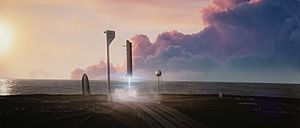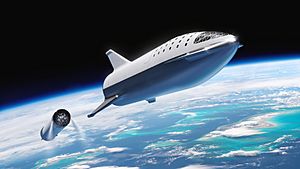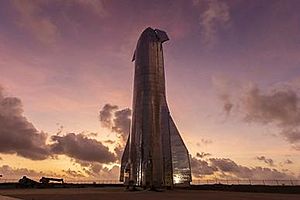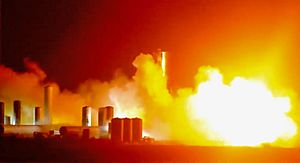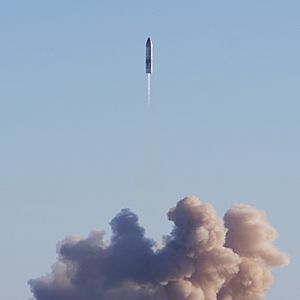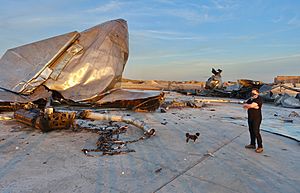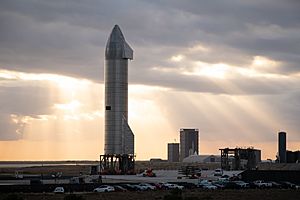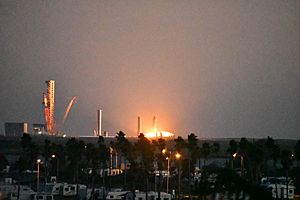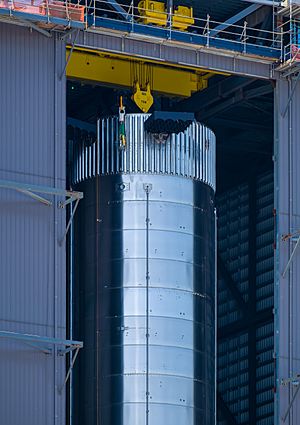SpaceX Starship development facts for kids
SpaceX Starship is the second part of the Starship system. Its journey began in 2005 when the company SpaceX first talked about a new rocket design. This rocket changed a lot over time. On July 25, 2019, a test vehicle called Starhopper made the first successful short flight at SpaceX Starbase in Boca Chica, Texas. Later, in May 2021, SN15 was the first test rocket to fly high and land successfully.
How Starship Began
In November 2005, SpaceX first mentioned a powerful rocket like Starship. Elon Musk, the head of SpaceX, briefly talked about a huge rocket called BFR. It would use a bigger engine than their usual ones.
As early as 2007, Musk shared his dream of helping humans explore and live on Mars. SpaceX started building the Raptor rocket engine before 2014. From 2011 to 2014, Musk hoped SpaceX would send people to Mars in the 2020s or 2030s.
Mars Colonial Transporter
In October 2012, Musk first shared a big plan for a reusable rocket system. This system would be much more powerful than the Falcon 9 rocket. It was part of SpaceX's Mars plan, then called the Mars Colonial Transporter (MCT).
The idea was to have reusable engines, rockets, and capsules. These would carry people to Mars and bring them back to Earth. SpaceX CEO Gwynne Shotwell said it could carry 150–200 tons to low Earth orbit. The MCT was meant to be a much larger version of the Falcon 9.
In June 2013, Musk said SpaceX would not offer its shares to the public until the "Mars Colonial Transporter is flying regularly."
By February 2014, the MCT's main cargo was a large spacecraft. It could carry up to 100 tonnes of people and supplies. According to SpaceX's engine chief, Tom Mueller, they could use nine Raptor engines on one rocket. This was like the Falcon 9 using nine Merlin engines. The rocket would be at least 10 meters wide. This is almost three times wider than the Falcon 9. It was planned to have up to three main parts with at least 27 engines.
Interplanetary Transport System
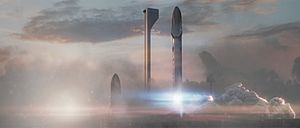
A drawing of the ITS at launch
|
|
| Function |
|
|---|---|
| Manufacturer | SpaceX |
| Country of origin | United States |
| Size | |
| Height | 122 m (400 ft) |
| Diameter | 12 m (39 ft) |
| Mass | 10,500 t (23,100,000 lb) |
| Stages | 2 |
| Capacity | |
| Payload to LEO | 300 t (660,000 lb) (reusable) 550 t (1,210,000 lb) (expendable) |
| Payload to Mars | 450 t (990,000 lb) (with refueling) |
| Associated rockets | |
| Derivatives | Big Falcon Rocket |
| Launch history | |
| Status | Developed into the BFR |
| Launch sites | KSC LC-39A |
| First stage – ITS Booster | |
| Length | 77.5 m (254 ft) |
| Diameter | 12 m (39 ft) |
| Empty mass | 275 t (606,000 lb) |
| Gross mass | 6,975 t (15,377,000 lb) |
| Propellant mass | 6,700 t (14,800,000 lb) |
| Engines | 42 Raptor |
| Thrust | 128 MN (29,000,000 lbf) |
| Specific impulse | 334 s (3.28 km/s) |
| Fuel | Subcooled LCH4 / LOX |
| Second stage – ITS Tanker | |
| Length | 49.5 m (162 ft) |
| Diameter | 12 m (39 ft) 17 m (56 ft) (incl. legs) |
| Empty mass | 90 t (200,000 lb) |
| Gross mass | 2,590 t (5,710,000 lb) |
| Propellant mass | 2,500 t (5,500,000 lb) |
| Engines | 3 Raptor 6 Raptor Vacuum |
| Thrust | 31 MN (7,000,000 lbf) |
| Fuel | Subcooled LCH4 / LOX |
| Second stage – Interplanetary Spaceship | |
| Length | 49.5 m (162 ft) |
| Diameter | 12 m (39 ft) 17 m (56 ft) (incl. legs) |
| Empty mass | 150 t (330,000 lb) |
| Gross mass | 2,100 t (4,600,000 lb) |
| Propellant mass | 1,950 t (4,300,000 lb) |
| Engines | 3 Raptor 6 Raptor Vacuum |
| Thrust | 31 MN (7,000,000 lbf) |
| Fuel | Subcooled LCH4 / LOX |
In 2016, Musk changed the name from Mars Colonial Transporter. He said the system could "go well beyond Mars." So, he renamed it the Interplanetary Transport System (ITS). That year, he shared more about the space mission, the rocket, and the Raptor engines. The first Raptor engine was tested in September 2016.
By October 2016, Musk said a test tank made of carbon-fiber worked well. It was tested with very cold liquids. A pressure test in November 2016 also went well.
In July 2017, Musk said the design had changed. It would now also support travel around Earth and to the Moon.
ITS Design Details
The ITS rocket had two main parts, or stages. The first stage was a booster to launch the rocket. The second stages could be an "Interplanetary Spaceship" for people or an "ITS tanker" for refueling in space. Both stages used Raptor engines.
The Raptor engine used liquid methane fuel and liquid oxygen to burn. Both fuels would enter the engine as gas. High-pressure gas would also push the fuel into the tanks. This removed the need for the old helium system used on Falcon 9.
The whole rocket, with both stages, was 122 meters tall. Both parts were to be made of light carbon fiber. This was a big change from the Falcon 9, which used aluminum. Both stages were designed to be fully reusable and land upright. The total weight at launch was 10,500 tonnes. It could carry 550 tonnes to low Earth orbit if not reused, or 300 tonnes if reused.
ITS Booster
The ITS booster was the first stage. It was 12 meters wide and 77.5 meters tall. It was designed to be reusable. It would have 42 engines, each making a lot of thrust. The total thrust at launch would be huge, much more than the Saturn V rocket.
The engines were arranged in rings. The center engines could move to steer the rocket. The booster was designed to land back at the launch pad. This would allow it to be refueled and launched again quickly.
Second Stage Spacecraft
The ITS did not have a simple second stage. Instead, the second stage was a spacecraft that could fly for a long time in space.
The Interplanetary Spaceship was designed to carry many passengers. It would act as the second stage for launch. It would also be a vehicle for cargo and people traveling between planets. After refueling in Earth orbit, it could carry up to 450 tonnes to Mars. It would use three Raptor engines for landing and taking off from Mars.
The ITS tanker was a special second stage for carrying fuel. It would transport up to 380 tonnes of fuel to low Earth orbit. This fuel would be used to refuel the Interplanetary Spaceships. After delivering the fuel, the tanker would return to Earth, land, and get ready for another flight.
Reusability
Both parts of the rocket were designed to be fully reusable. They would land vertically, using technology from the Falcon 9.
Making the ITS fully and quickly reusable was key to lowering space travel costs. SpaceX believed this alone would make space travel much cheaper. Musk said this was more than half of what was needed to build a lasting settlement beyond Earth.
Big Falcon Rocket
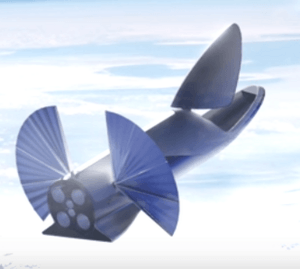
2017 drawing of the Big Falcon Ship (BFS) with its cargo door open
|
|
| Function |
|
|---|---|
| Manufacturer | SpaceX |
| Country of origin | United States |
| Size | |
| Height | 106 m (348 ft) |
| Diameter | 9 m (30 ft) |
| Stages | 2 |
| Capacity | |
| Payload to LEO | 150 t (330,000 lb) (reusable) |
| Associated rockets | |
| Derivatives | SpaceX Starship system |
| Launch history | |
| Status | Developed into the Starship system |
| Launch sites | KSC LC-39A |
| First stage – Big Falcon Booster | |
| Diameter | 9 m (30 ft) |
| Engines | 31 Raptor |
| Thrust | 62 MN (14,000,000 lbf) |
| Fuel | Subcooled LCH4 / LOX |
| Second stage – Big Falcon Ship | |
| Diameter | 9 m (30 ft) |
| Engines | 2 (later 3) sea-level Raptor 4 vacuum Raptor |
| Fuel | Subcooled LCH4 / LOX |
In September 2017, Musk announced a new rocket called the Big Falcon Rocket (BFR). He said they were looking for a better name. Its goal was to send two cargo missions to Mars by 2022. These missions would find water and prepare for future flights. Then, four ships would follow in 2024. Two would carry people, and two would carry equipment for a fuel plant.
The design changed to balance how much it could carry, its landing ability, and how reliable it was. The first design had six Raptor engines. The engine layout, landing flaps, and even the material changed later.
By September 2017, Raptor engines had been tested for 20 minutes in total. The longest test was 100 seconds. SpaceX also looked for places to build the BFR in California, Texas, Louisiana, and Florida. By early 2018, the first carbon composite ship was being built. SpaceX also started a new factory at the Port of Los Angeles.
In March, SpaceX said it would build its rocket and spaceship at the Port of Los Angeles. By May, about 40 SpaceX workers were on the BFR project. SpaceX planned to move the rocket by barge through the Panama Canal to Cape Canaveral for launch.
In August 2018, the US military showed interest in the BFR. They liked its ability to move up to 150 tonnes of cargo anywhere in the world in under 30 minutes. They said it would cost less than a C-5 plane.
BFR Design
The BFR was 106 meters tall and 9 meters wide. It was made of carbon-fiber.
The top part, called the Big Falcon Ship (BFS), had small wings at the back. These wings helped control the ship during flight and landing. The BFS originally had six Raptor engines. Later, a seventh engine was added to improve safety and allow for heavier landings.
Three types of BFS were planned: BFS cargo, BFS tanker, and BFS crew. The cargo version would go to Earth orbit and carry cargo to the Moon or Mars. After refueling in Earth orbit, it could land on the Moon and return to Earth without more refueling.
The BFR could also carry people or cargo from one place on Earth to another. It could deliver its payload anywhere in 90 minutes.
Starship and Super Heavy
In 2018, Musk announced a planned trip around the Moon in 2023. This mission was called #dearMoon project. He showed a new BFS design with three rear fins and two front fins. This replaced the old wing design. The new design used seven Raptor engines. The fins at the base would also act as landing legs.
The two main parts were renamed: Starship (the second stage) and Super Heavy (the booster stage). In 2019, SpaceX started calling the Starship/Super Heavy combination the SpaceX Starship system.
Stainless Steel Design
In January 2019, Musk announced a big change: Starship and Super Heavy would be made from stainless steel instead of carbon fiber. He said stainless steel was cheap and fast to work with. He also said it was actually lighter. This is because at very cold temperatures, stainless steel becomes 50 percent stronger. The high melting point of the steel would also mean no heat shield was needed on the side facing space. The side facing Earth would be cooled by fuel or water flowing through tiny holes in the steel.
Both rockets were built by stacking steel cylinders (rings) and welding them together.
In 2019, the design went back to six Raptor engines. Three were for use at sea-level, and three were for use in space (vacuum). Early Super Heavy test flights would use fewer engines, maybe around 20.
Later in 2019, Musk said Starship would weigh 120 tonnes empty. It would be able to carry 100 tonnes of payload, growing to 150 tonnes over time.
The Raptor engine design was improved. Higher thrust versions were tested successfully. The number of engines was reduced from 37 to 31 in 2020. Musk said SpaceX would do hundreds of cargo flights before carrying people.
In February 2021, SpaceX raised $3.5 billion more in funding. In April, SpaceX said Earth-to-Earth passenger flights would be common within five years.
Tests in 2020-2021 made SpaceX confident enough to make Starship's body flaps narrower and lighter.
Starship Prototypes
SpaceX prototypes go through many tests before they launch. First, they do pressure tests. The tanks are filled with liquid or gas to check their strength. SpaceX might even test them until they burst to find their limits. Later prototypes have their engines tested while tied to the ground (called a static fire). After these tests, vehicles either fly in the atmosphere or launch into orbit.
| Name | First Seen | First Engine Test | First Flight | Retired | Built At | Status | Flights |
|---|---|---|---|---|---|---|---|
| Starhopper | December 2018 | 3 April 2019 | 25 July 2019 | August 2019 | Boca Chica, Texas | Repurposed | 2 |
| Mk1 | December 2018 | N/A | N/A | 20 November 2019 | Boca Chica, Texas | Destroyed | 0 |
| Mk2 | May 2019 | N/A | N/A | November 2019 | Cocoa, Florida | Scrapped | 0 |
| Mk3/SN1 | October 2019 | N/A | N/A | 28 February 2020 | Boca Chica, Texas | Destroyed | 0 |
| Mk4 | September 2019 | N/A | N/A | November 2019 | Cocoa, Florida | Scrapped | 0 |
| SN3 | March 2020 | N/A | N/A | 3 April 2020 | Boca Chica, Texas | Destroyed | 0 |
| SN4 | April 2020 | 5 May 2020 | N/A | 29 May 2020 | Boca Chica, Texas | Destroyed | 0 |
| SN5 | April 2020 | 27 July 2020 | 4 August 2020 | February 2021 | Boca Chica, Texas | Scrapped | 1 |
| SN6 | May 2020 | 23 August 2020 | 3 September 2020 | January 2021 | Boca Chica, Texas | Scrapped | 1 |
| SN8 | July 2020 | 20 October 2020 | 9 December 2020 | 9 December 2020 | Boca Chica, Texas | Destroyed | 1 |
| SN9 | August 2020 | 6 January 2021 | 2 February 2021 | 2 February 2021 | Boca Chica, Texas | Destroyed | 1 |
| SN10 | September 2020 | 23 February 2021 | 3 March 2021 | 3 March 2021 | Boca Chica, Texas | Destroyed | 1 |
| SN11 | September 2020 | 22 March 2021 | 30 March 2021 | 30 March 2021 | Boca Chica, Texas | Destroyed | 1 |
| SN12 | September 2020 | N/A | N/A | February 2021 | Boca Chica, Texas | Scrapped | 0 |
| SN13 | October 2020 | N/A | N/A | February 2021 | Boca Chica, Texas | Scrapped | 0 |
| SN14 | October 2020 | N/A | N/A | February 2021 | Boca Chica, Texas | Scrapped | 0 |
| SN15 | November 2020 | 26 April 2021 | 5 May 2021 | 31 May 2021 | Boca Chica, Texas | Retired | 1 |
| SN16 | December 2020 | Not Yet | Not Yet | Unknown | Boca Chica, Texas | Retired | 0 |
| SN17 | December 2020 | N/A | N/A | May 2021 | Boca Chica, Texas | Scrapped | 0 |
| SN18 | January 2021 | N/A | N/A | June 2021 | Boca Chica, Texas | N/A | 0 |
| SN19 | February 2021 | N/A | N/A | June 2021 | Boca Chica, Texas | N/A | 0 |
| SN20/Ship 20 | March 2021 | 21 October 2021 | N/A | Not Yet | Boca Chica, Texas | Retired | 0 |
| Ship 21 | 3 July 2021 | Not Yet | Not Yet | Not Yet | Boca Chica, Texas | Scrapped | 0 |
| Ship 22 | September 2021 | Not Yet | Not Yet | Not Yet | Boca Chica, Texas | Suspended | 0 |
| Ship 23 | October 2021 | Not Yet | Not Yet | Not Yet | Boca Chica, Texas | Suspended | 0 |
| Ship 24 | November 2021 | Not Yet | Not Yet | Not Yet | Boca Chica, Texas | In service (ground testing) | 0 |
| Ship 25 | January 2022 | Not Yet | Not Yet | Not Yet | Boca Chica, Texas | Under Construction | 0 |
Starhopper
Building the first test vehicle, Starhopper, started in Boca Chica in 2018. It was made of stainless steel. Starhopper had one engine. It was used to test how to land and control the rocket at low speeds and altitudes.
In early 2019, a main goal was to finish the tanks for liquid methane and oxygen. Starhopper's lower tank section was moved to the launch pad on March 8. Testing began in March. Starhopper was filled with liquid oxygen and methane to test its systems. A storm damaged Starhopper's nose cone. SpaceX decided to test it without the nose cone.
Starhopper Flight Tests
On April 3, 2019, SpaceX did a static fire test. The engine fired for a few seconds and was successful. The vehicle might have lifted a few inches. Two days later, in another test, it rose about 1 meter.
By May 2019, SpaceX planned more tests in Florida. SpaceX started building two high-altitude prototypes at the same time. Mk1 was in Texas and Mk2 in Florida. They shared ideas and building methods. These vehicles had three Raptor engines and were meant to fly up to 5 km high. An Mk3 prototype began building in late 2019.
In September, movable fins were added to Mk1. On July 25, Starhopper made its first "hop" flight, reaching about 20 meters high. A second hop on August 27 went about 150 meters high. It landed about 100 meters from the launchpad. This was the first time the Raptor engine was used in flight.
Mark Series (Mk1 - Mk4)
In September, Musk showed Starship Mk1. It was 9 meters wide and about 50 meters tall. It weighed 200 tonnes empty. It was meant to test flight and landing. It had three Raptor engines, fins, and a nose cone. All these were removed after the presentation.
Mk4 construction started in Florida in October. A few weeks later, work in Florida stopped. Mk4 was scrapped. Some parts built in Florida were moved to Texas.
On November 20, 2019, Mk1 broke apart during a pressure test. Mk2 was never finished. Work moved to Mk3 and Mk4.
In December 2019, Musk renamed Mk3 to Starship SN1. He said small design improvements would continue up to SN20. In January 2020, SpaceX did pressure tests. One test intentionally destroyed a tank by over-pressurizing it to 7.1 bar. Another tank was tested twice. In the first test, it held 7.5 bar before leaking. After repairs, it burst at 8.5 bar. This test was a success because 8.5 bar was 1.4 times the normal pressure.
SpaceX started building parts for SN1 in December 2019. It began putting SN1 together in February 2020. SN1 was destroyed during a test on February 28. This was due to a design problem in the lower part of the tank.
Hops (SN3 - SN6)
Musk said SN3 would be for engine tests and short hops. SN4 would be for longer flights.
SN3 was destroyed during testing on April 3, 2020. This happened because of a wrong test setup. A valve opened incorrectly, releasing pressure. The section crumpled, and the top fell off. SN4 was built using parts of SN3 that were not damaged.
SN4 passed a pressure test on April 26. It was the first prototype since SN2 to do so. SN4 passed two engine tests on May 5 and 7. After removing the engine, another pressure test was done on May 19. Vibrations caused a fuel leak that caught fire. The fire damaged the rocket's base. SN4 was destroyed after an engine test on May 29. This was due to a problem with the ground equipment.
In March, Musk aimed for an orbital flight of Starship by the end of 2020. After an engine test on July 30, SN5 flew 150 meters on August 4. SN6 completed an engine test on August 24. It then flew 150 meters on September 3.
In March 2021, SN5 was scrapped. SN6 followed in January 2021.
Flights (SN8 - SN19)
SN8 was planned to be made of 304L stainless steel. In late October and November, SN8 survived four engine tests. The launch happened on December 9. Launch, ascent, turning, and controlled descent were successful. But low pressure in the fuel tank caused the engines to not produce enough thrust for landing. SN8 crashed and was destroyed.
On December 11, the stand under SN9 failed. This caused the vehicle to tip and hit the building walls. SN9 needed a new front flap. SN9 did 6 engine tests in January 2021. Two engines had to be replaced. After getting permission, SN9 flew 10 km on February 2. The flight was stable. But one engine failed, causing SN9 to crash into the landing pad. The landing pad was then made stronger with more concrete. After SN9's failure, all three engines were used for landing. This provided a backup if one failed.
SN10 passed its first pressure test on February 8. An engine test followed on February 23. After an engine change, another test happened on February 25.
Two launch attempts were made on March 3. The first was stopped automatically because one engine produced too much thrust. After a 3-hour delay, the second attempt landed without exploding. It followed the SN8/SN9 flight path. The test ended with a hard landing, likely due to a problem with the fuel tank. Three landing legs did not lock, causing a slight lean. Eight minutes later, the prototype exploded, possibly from a methane leak.
SN11 passed a pressure test on March 12. This included testing its control system. An engine test followed on March 15, but it was stopped. Another engine test was tried on March 26. A 10 km flight test happened in heavy fog on March 30. The test included engine shutdowns, a flip maneuver, and descent. There was a fire on engine 2 during the ascent. Just after the engine was restarted for landing, SN11 lost contact and broke apart. A small methane leak caused a fire on engine 2. This damaged the electronics, leading to a hard start during landing. SN12 through SN14 never launched.
SN15 had improved software, a new fuel system, and a new Raptor engine design. A Starlink antenna was also new. SN15 went through pressure tests in April. Then, engine tests followed on April 26 and 27. A 10 km high-altitude flight test happened on May 5. It achieved a soft landing. A small fire near the base was put out quickly. After its engines were removed, it was retired on May 31. It was the first Starship prototype to fly, land, and be saved. SN16, SN17, SN18, and SN19 were scrapped or canceled.
Orbital Launches (SN20/Ship 20-)
SN20 (Ship 20) was planned to launch on top of the Super Heavy booster. SN20 has a thermal protection system (heat shield) covering much of it.
SN20 was moved to the launch pad on August 5, 2021. It was placed on Booster 4 for a fit test. The prototype was expected to fly on booster BN4. SpaceX said in May 2021 that the orbital flight would launch from Boca Chica. After separating, Starship would go into orbit. About 90 minutes later, it would try to land softly in the ocean near Kauai.
Ship 21 was scrapped. Ship 22 was moved to the "Rocket Display Garden" in February 2022 and is likely retired. Ship 23 was scrapped and partly used for Ship 24. Ship 24 is built, and parts for Ship 25 and Ship 26 have been seen.
Super Heavy Prototypes
| Name | First Seen | First Engine Test | First Flight | Retired | Built At | Status | Flights |
|---|---|---|---|---|---|---|---|
| BN1 | September 2020 | N/A | N/A | 30 March 2021 | Boca Chica, Texas | Scrapped | 0 |
| BN3/B3 | March 2021 | 19 July 2021 | N/A | 14 August 2021 | Boca Chica, Texas | Scrapped | 0 |
| B4 | 3 July 2021 | Not Yet | Not Yet | 25 March 2022 | Boca Chica, Texas | Retired | 0 |
| B5 | 19 July 2021 | Not Yet | Not Yet | December 2021 | Boca Chica, Texas | Scrapped | 0 |
| B7 | 29 September 2021 | Not Yet | Not Yet | Not Yet | Boca Chica, Texas | Undergoing repairs | 0 |
| B8 | 25 January 2022 | Not Yet | Not Yet | Not Yet | Boca Chica, Texas | Under Construction | 0 |
Boosters do not have an engine skirt. Without engines, boosters are about 3 meters shorter.
BN1
BN1 was the first Super-Heavy Booster prototype. It was a test model not meant for flight. Sections of the 70-meter tall test article were made in the fall. Building started in December 2020. BN1 was fully stacked inside the High Bay on March 18.
BN3/B3
BN3 (Booster 3) was used for ground tests. A pressure test with cold liquids was done on July 13. Booster 3 was fully stacked on June 29. It moved to the test pad without engines. Three engines were later added to B3.
An engine test was done on July 19. BN3/Booster 3 was partly scrapped on August 15.
B4
Booster 4 was first seen on July 3. Musk asked hundreds of SpaceX workers to move to Boca Chica. This was to speed up the building of SN20, BN4, and the launch platform. The goal was to have the Starship system ready by August 5. BN4 was fully stacked on August 1. All 29 engines were installed on August 2. Fins were added for landing tests. However, the fins on Booster 4 did not fold down for launch.
SN20 was stacked on top of Booster 4 on August 6 for a fit test. This made it the largest rocket ever. Booster 4 was then returned to the High Bay for wiring. On September 9, Booster 4 came back to the launch site on the Orbital Launch mount.
B4 completed its first cold pressure test on December 17. It also did a pneumatic pressure test on December 19. It went through another cold pressure test. B4 and Ship 20 were then retired.
B5
Parts for B5 were seen as early as July 19. Building for BN5 finished in November. However, on December 8, B5 was retired.
B7
Parts for B7 were spotted on September 29. B7 was placed on the orbital launch mount on March 31, 2022. After a cold pressure test on April 4, 2022, it was moved to the new booster test stand on April 8. B7 completed another cold test on April 14, but a part inside broke. On April 18, B7 returned for repairs. On May 5, B7 was again placed on the orbital launch mount. B7 then completed two more cold tests on May 9 and 11. It then moved into a new large building for more repairs and upgrades.
On July 11, Booster 7 tried a spin prime test. This is where the engine pumps spin up without lighting the engines. However, during the test, there was a small explosion. Elon Musk first said there was minor damage. It was later moved back for inspection and repairs.
B8
Parts for B8 were seen on January 25.
Test Tanks
The tanks are listed as follows:
| Name | First Seen | Retired | Built At | Current Location | Status | Tests |
|---|---|---|---|---|---|---|
| TT1 | January 2020 | 10 January 2020 | Boca Chica, Texas | N/A | Intentionally destroyed | 1 |
| LOX HT | January 2020 | 25 January 2020 | Boca Chica, Texas | N/A | Intentionally destroyed | 2 |
| TT2 | January 2020 | 28 January 2020 | Boca Chica, Texas | N/A | Intentionally destroyed | 2 |
| SN2 | February 2020 | March 2020 | Boca Chica, Texas | Production site | Retired | 1 |
| SN7 | May 2020 | 23 June 2020 | Boca Chica, Texas | N/A | Intentionally destroyed | 2 |
| SN7.1 | July 2020 | 22 September 2020 | Boca Chica, Texas | N/A | Intentionally destroyed | 2 |
| SN7.2 | December 2020 | 22 May 2021 | Boca Chica, Texas | Production site | Retired | 2 |
| BN2.1 | 3 June 2021 | 25 June 2021 | Boca Chica, Texas | Production site | Retired | 2 |
| GSE 4.1 | August 2021 | 18 January 2021 | Boca Chica, Texas | Intentionally destroyed | 2 | |
| B2.1 | October 2021 | 6 December 2021 | Boca Chica, Texas | Production site | Retired | 3 |
| B6 | October 2021 | Not Yet | Boca Chica, Texas | Production site | Idle | 0 |
| B7.1 | 2022 | Not Yet | Boca Chica, Texas | Launch site | Testing | 4 |
| EDOME | 2022 | Not Yet | Boca Chica, Texas | Launch site | Idle | 0 |
TT1, LOX HTT, and TT2
Test Tank 1 (TT1) was a smaller test tank. It was used to test new materials and building methods. On January 10, 2020, TT1 was tested until it broke. It reached a pressure of 7.1 bar.
Liquid Oxygen Header Test Tank (LOX HTT) was like TT1. It was based on the liquid oxygen tank inside a nosecone. On January 24, 2020, the tank was pressure tested for several hours. The next day, it was tested until it broke.
Test Tank 2 (TT2) was another smaller test tank like TT1. On January 27, 2020, TT2 was pressure tested. It reached 7.5 bar before a leak happened. Two days later, it was tested until it burst at 8.5 bar.
Starship Test Tanks
SN2 was a half-size test tank. It was used to test welding quality and the engine mount design. The engine mount is at the bottom of the vehicle. Later Starship tests would have up to three Raptor engines there. SN2 passed a pressure test on March 8, 2020.
SN7 was a test article for switching to a new type of stainless steel (304L). A cold pressure test was done in June 2020. It reached 7.6 bar before a leak. During a test to failure on June 23, 2020, the tank burst at an unknown pressure.
SN7.1 was the second 304L test tank. The goal was to reach a higher failure pressure. The tank was tested many times in September. It was tested until it broke on September 23. The tank burst at 8 bar near the top.
SN7.2 was made to test thinner walls, which would make the rocket lighter. It is thought to be made from 3 mm steel sheets instead of 4 mm. On January 26, 2021, SN7.2 passed a cold pressure test. On February 4, during a test to failure, the tank developed a leak, which was fixed. On March 15, SN7.2 was retired.
Super Heavy Test Tanks
BN2.1 was rolled out on June 3, 2021, for cold tests on June 8 and June 17.
B2.1 (not BN2.1) had cold tests on December 1, 2, and 3. Then it was retired.
Parts for B6 were seen on August 22, 2021. On December 8, 2021, B6 was planned to become a test tank.
B7.1 was first cold pressure tested on June 28, 2022. It was tested again on July 19, 2022. During a test to failure two days later, it had minor damage. After repairs, it went through a fourth cold pressure test on July 27, 2022.
GSE Test Tanks
GSE 4.1 was first seen in August 2021. It was the first ground support equipment (GSE) test tank. It was made from parts of GSE 4. It had a cold pressure test on August 23. It was tested until it broke on January 8, 2022.
Other Test Tanks
EDOME is a simpler test tank that has not been tested yet.


